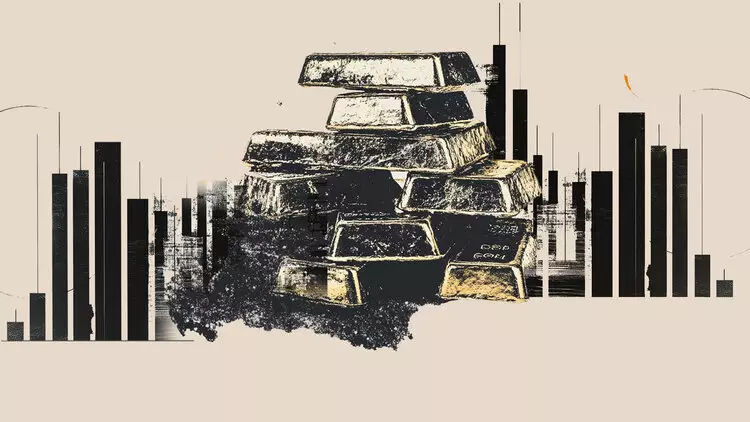In an era dominated by geopolitical tensions and unpredictable trade policies, gold continues to assert its position as a beacon of stability. Its recent price movements reveal a complex interplay of global economic cues, policy developments, and market sentiment. While the precious metal maintains a steady bid tone, underlying tensions keep traders cautious, highlighting the importance of discernment in timing and strategy. Gold’s resilience is not merely a reflection of safe-haven appeal but also a testament to its nuanced response to macroeconomic signals and political uncertainties.
The recent decline of the US dollar, largely influenced by dovish comments from Federal Reserve officials and concerns surrounding trade tariffs, has provided a supportive backdrop for gold. The Fed’s cautious stance — notably, hints at potential interest rate cuts amidst mounting economic risks — has kept the dollar subdued, thus making gold more attractive to investors. However, this environment also fosters ambiguity; traders are hesitant to jump headlong into bullish bets without clearer directional cues. The lack of significant economic data from the US on Monday acts as a delaying factor, emphasizing patience over impulsiveness in market positioning.
What makes this scenario particularly compelling is how geopolitical threats, especially the unpredictability of US tariffs, are elevating gold’s safe-haven credentials. President Trump’s aggressive tariff strategies against China, Europe, and other trade partners introduce a persistent layer of risk. Despite the supposed goal of protecting American industries, the economic fallout—such as rising consumer prices—casts doubt on the efficacy of such measures. This has created an environment where gold is increasingly viewed as a refuge, yet potential policy shifts and market reactions make it difficult to establish firm directional bets.
Trade Tensions and Monetary Policy: Navigating a Watershed Period
The central focus remains on the uncertain path of US monetary policy amid escalating trade tensions. The Federal Reserve’s recent hints at a possible rate cut, combined with market pricing for multiple adjustments by year-end, injects significant volatility into the Forex and commodities markets. The Fed’s dovish rhetoric, supported by Governor Christopher Waller’s recent comments, suggests a cautious approach, yet many market participants remain skeptical about an imminent move. The seeming contradiction between the Fed’s potential easing and the market’s expectations for rate cuts presents a paradox that keeps gold in a delicate balancing act.
At the same time, the intensification of trade disputes amplifies concerns about the broader economic impact. The prospect of steep tariffs, especially on the European Union and other major trading partners, is likely to strain global supply chains and inflate costs, pushing investors towards safe havens. The rising optimism reflected in consumer sentiment surveys adds another layer of complexity; it signals underlying confidence that may counteract some of gold’s safe-haven appeal. Nevertheless, traders are clearly prioritizing geopolitical risks over short-term economic optimism, which sustains demand for gold.
Complicating matters further are mixed signals from policymakers. While some officials advocate for rate cuts to stimulate growth, others highlight inflation risks from the tariffs, potentially supporting the USD. The expectation of two rate cuts by the end of the year, despite market doubts about immediate easing, underscores a policy landscape rife with uncertainty. This ambiguity benefits gold, yet also demands vigilance, as any unexpected policy shift or economic indicator can quickly alter the market narrative.
Technical Trends and Strategic Considerations for Investors
From a technical perspective, gold’s price action suggests a cautious market awaiting a catalyst for a decisive move. Resistance levels approaching the $3,365–3,366 zone serve as critical battlegrounds for bullish investors. A sustained break above these levels could propel gold toward $3,400, with further upside potential to around $3,435. Conversely, support levels near $3,325–3,322 and the close vicinity of $3,300 serve as crucial safeguards against deeper declines.
The consolidation within a defined range indicates that traders are evaluating whether the current environment warrants new positions. The inability of gold to sustain gains beyond resistance highlights a market hungry for confirmation signals. Should selling pressure break below $3,283–3,282, the subsequent slide toward the June lows around $3,248–3,247 is plausible, hinting at a shift in market sentiment toward bearishness.
In practical terms, investors should adopt a measured approach: awaiting a definitive breakout before committing larger positions. The strategic focus must be on identifying false breakouts or reversals that can signal whether gold’s rally is sustainable or a temporary flight to safety. In an environment characterized by trade disputes and uncertain policy signals, patience and discipline are paramount for success.
The Broader Implications of Tariffs and Trade Policies on Gold
The ongoing use of tariffs as a tool of protectionism underscores a fundamental shift in global trade dynamics. While designed to shield domestic industries and address trade imbalances, tariffs often engender retaliatory measures that threaten to escalate into broader trade wars. This tit-for-tat escalation can heighten market volatility, elevate inflationary pressures, and reinforce gold’s appeal as a hedge against economic instability.
Historically, tariffs have been double-edged swords: they may provide short-term relief to certain sectors but often at the expense of long-term economic growth and market confidence. The US’s focus on China, Mexico, and Canada, which together account for a significant share of its imports, illustrates the strategic importance of trade relations. Nonetheless, the revenue generated from tariffs is frequently redirected towards domestic priorities such as tax cuts, further complicating fiscal and monetary interactions.
In the context of gold investment, the rising use of tariffs and trade tensions serve as persistent tailwinds. Investors face a landscape where geopolitical risks are more prominent than ever, and gold’s traditional role as a safe haven becomes increasingly relevant. Yet, it is vital to recognize that this environment also demands vigilance for policy shifts that could abruptly alter market perceptions.
The confluence of these factors creates a fragile yet potentially rewarding trading environment. Gold’s appeal hinges not only on current uncertainties but also on how swiftly and effectively markets can navigate the intricate dance of policy signals, geopolitical tensions, and economic data. For investors willing to embrace the challenge, understanding these dynamics is essential to harnessing gold’s true potential amid tumultuous times.

